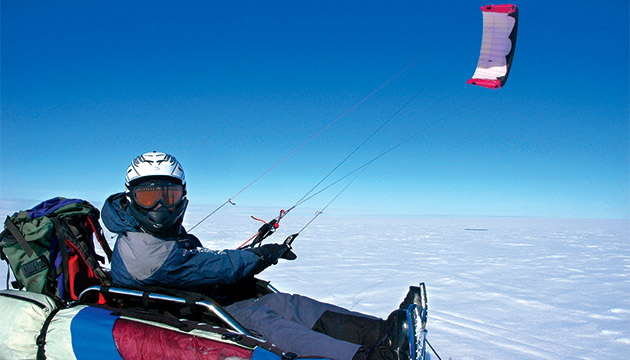Ben Deacon has long had a dream to travel across Antarctica to the South Pole. Now he’s discovered a new way to get there that’s easier on the body, the wallet and the environment.
Ben Deacon’s love of cold places began in the New South Wales’ Snowy Mountains. He spent his youth climbing the many summits of the Main Range and skiing down them. It was during this time he began to dream of travelling to the South Pole. “I started researching what it took to achieve this, and I was astounded by the cost, both physical, and financial,” Ben says.
With a flight back from the Pole, the cost of an expedition is close to $400,000. The cost of a barrel of aviation fuel alone in Antarctica is more than $20,000. And the physical cost is extraordinary. “A friend of mine did an expedition there a few years ago,” Ben says. “He was a big bloke, weighed 110 kilos. He lost 35 kilos on the trip. I weigh 70.”
Ben came to the conclusion that exploring the Poles this way wasn’t sustainable physically, financially, or environmentally, through the use of hundreds of thousands of dollars worth of fuel. He thought there had to be a better way.
In an old photo from one of Mawson’s expeditions Ben noticed a sail fixed to a sled. He wondered whether a person could sail across an icecap, the way a yacht sails across the ocean.
About this time kite-surfing was just taking off as a sport. Ben describes kite-surfing as “21st century sailing, where a wing-like kite replaces the sail”. The beauty of the kite is that without a mast, you can have a very large kite on a very small machine. “Kites offered the power I needed to sail to the South Pole,” Ben says.
To test these ideas he returned to the Snowy Mountains with an old friend, Pat Spiers. Together they pioneered a new way of skiing, towed to the top of mountains not by chairlifts but by giant kites. Pat remembers their first time: “We swooped the kites into action and just went racing off over the mountains and valleys which previously had only been reachable by a steady slog on cross-country skis”. In fact in their first season, they were able to sail to the top of Mount Kosciuszko, powered by nothing but the wind. “I knew I had the power source I needed, but now I needed the vehicle,” Ben says.
There was only one man Ben knew who could build this machine – Kiwi Inventor Peter Lynn. “Peter is like the Willy Wonka of dangerous sports,” Ben says. “He’s a prolific inventor, and one of the pioneers of kite surfing. He also had a reputation for not suffering fools, so I was surprised when he said he’d take on the project.”
Ben met Peter in his New Zealand workshop. They had some engineering challenges to overcome, particularly how to make the sled steer without causing lots of friction. “We sat in his study, drinking tea and trying to come up with a solution,” Ben says. “The next thing I knew Peter leapt to his feet and said, “I know, I know how we’re going to do it. It’s brilliant, I’ve got it”.
This story excerpt is from Issue #54
Outback Magazine: Aug/Sep 2007










